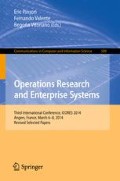Abstract
The discriminant analysis is essential knowledge in science, technology and industry. But, there are four serious problems. These are resolved by Revised IP–OLDF and k–fold cross validation.
Access this chapter
Tax calculation will be finalised at checkout
Purchases are for personal use only
Notes
- 1.
This data was used for the description of three statistical books using SAS, SPSS and JMP. It is download from (http://sun.econ.seikei.ac.jp/~shinmura/). Click Tab of “Data Archive” and double click “aoyama.xls”.
- 2.
This data is open to the paper about DEA (Table 1 in Page 4. http://repository.seikei.ac.jp/dspace/handle/10928/402).
References
Fisher, R.A.: The use of multiple measurements in taxonomic problems. Ann. Eugenics 7, 179–188 (1936)
Fisher, R.A.: Statistical Methods and Statistical Inference. Hafner Publishing Co., New York (1956)
Flury, B., Rieduyl, H.: Multivariate Statistics: A Practical Approach. Cambridge University Press, UK (1988)
Friedman, J.H.: Regularized discriminant analysis. J. Am. Stat. Assoc. 84(405), 165–175 (1989)
Goodnight, J.H.: SAS Technical report—the sweep operator: its importance in statistical computing—(R100). SAS Institute Inc., Cary, US (1978)
Lachenbruch, P.A., Mickey, M.R.: Estimation of error rates in discriminant analysis. Technometrics 10, 1–11 (1968)
Liitschwager, J.M., Wang, C.: Integer programming solution of a classification problem. Manage. Sci. 24(14), 1515–1525 (1978)
Sall, J.P.: SAS Regression Applications. SAS Institute Inc, Cary (1981). Japanese version is translated by Shinmura, S
Sall, J.P., Creighton, L., Lehman, A.: JMP Start Statistics, 3rd edn. SAS Institute Inc, Cary (2004). Japanese version is edited by Shinmura, S
Schrage, L.: LINDO—An Optimization Modeling System. The Scientific Press, South San Francisco (1991). Japanese version is translated by Shinmura, S., Takamori, H
Schrage, L.: Optimization Modeling with LINGO. LINDO Systems Inc, Chicago (2006). Japanese version is translated by Shinmura, S
Shinmura, S., Miyake, A.: Optimal linear discriminant functions and their application. COMPSAC 79, 167–172 (1979)
Shinmura, S.: Optimal linear discriminant functions using mathematical programming. J. Jpn. Soc. Comput. Stat. 11/2, 89–101 (1998)
Shinmura, S.: A new algorithm of the linear discriminant function using integer programming. New Trends. Probab. Stat. 5, 133–142 (2000)
Shinmura, S.: New algorithm of discriminant analysis using integer programming. In: IPSI 2004 Pescara VIP Conference CD-ROM, pp. 1–18 (2004)
Shinmura, S.: Overviews of discriminant function by mathematical programming. J. Jpn. Soc. Comput. Stat. 20(1-2), 59–94 (2007)
Shinmura, S.: Improvement of CPU time of revised IPLP-OLDF using linear programming. J. Jpn. Soc. Comput. Stat. 22(1), 37–57 (2009)
Shinmura, S.: The Optimal Linear Discriminant Function. Union of Japanese Scientist and Engineer Publishing, Japanese (2010)
Shinmura, S.: Problems of discriminant analysis by mark sense test data. Jpn. Soc. Appl. Stat. 40(3), 157–172 (2011)
Shinmura, S.: Beyond Fisher’s Linear Discriminant Analysis—New World of Discriminant Analysis. In: 2011 ISI CD-ROM, pp. 1–6 (2011)
Shinmura, S.: Evaluation of Optimal Linear Discriminant Function by 100-fold cross validation. In: 2013 ISI CD-ROM, pp. 1–6 (2013)
Shinmura, S.: End of Discriminant Functions Based on Variance Covariance Matrices. In: 2014 ICORE, pp. 5–16 (2014)
Shinmura, S.: Improvement of CPU time of linear discriminant functions based on MNM criterion by IP. Stat. Optim. Inf. Comput. 2, 114–129 (2014)
Stam, A.: Non-traditinal approaches to statistical classification: some perspectives on Lp-norm methods. Ann. Oper. Res. 74, 1–36 (1997)
Taguchi, G., Jugulu, R.: The Mahalanobis-Taguchi Strategy—A Pattern Technology System. Wiley, New York (2002)
Markowitz, H.M.: Portfolio Selection, Efficient Diversification of Investment. Wiley, New York (1959)
Miyake, A., Shinmura, S.: Error rate of linear discriminant function. In: de Dombal, F.T., Gremy, F. (eds.) Decision Making and Medical Care, North-Holland Publishing Company, pp. 435–445. North-Holland Publishing Company, New York (1976)
Vapnik, V.: The Nature of Statistical Learning Theory. Springer, Heidelberg (1995)
Warmack, R.E., Gonzalez, R.C.: An algorithm for the optimal solution of linear inequalities and its application to pattern recognition. IEEE Trans. Comput. C-2212, 1065–1075 (1973)
Author information
Authors and Affiliations
Corresponding author
Editor information
Editors and Affiliations
Rights and permissions
Copyright information
© 2015 Springer International Publishing Switzerland
About this paper
Cite this paper
Shinmura, S. (2015). Four Serious Problems and New Facts of the Discriminant Analysis. In: Pinson, E., Valente, F., Vitoriano, B. (eds) Operations Research and Enterprise Systems. ICORES 2014. Communications in Computer and Information Science, vol 509. Springer, Cham. https://doi.org/10.1007/978-3-319-17509-6_2
Download citation
DOI: https://doi.org/10.1007/978-3-319-17509-6_2
Published:
Publisher Name: Springer, Cham
Print ISBN: 978-3-319-17508-9
Online ISBN: 978-3-319-17509-6
eBook Packages: Computer ScienceComputer Science (R0)

